I have read numerous statements suggesting that the federal government’s 340B Drug Pricing Program helps hospitals and other healthcare providers serve the uninsured and underinsured at no cost to taxpayers. And in fact, that is one of the selling points among program advocates. But is it true? That depends on your perspective. It also depends on how you define cost.
Needless to say, there is more than one way to measure whether or not taxpayers bear the burden of providing program participants with deeply discounted drugs. If your only measurement is a direct tax payment, you could argue that 340B truly is a ‘no cost to taxpayers’ program. But if you measure other costs that arise as a result of the program, you might come away with a different opinion.
How the Program Works
Understanding how the 340B program works goes a long way toward answering the question at hand. When Congress established the program in 1992, they mandated that any drug companies wanting to participate in Medicare or Medicaid must sell certain outpatient drugs to program participants at deeply discounted prices.
Program participants, also known as covered entities, were primarily safety-net hospitals. The idea was to help them to stretch their federal funds further by not having to pay so much for prescription medications. The main goal of 340B remains the same today, with covered entities working with organizations like Ravin consultants to establish compliant 340B programs.
Think of it this way: if a hospital does not have to spend so much federal money purchasing prescription drugs it will ultimately dispense to poor and needy patients, it can either sell the drugs to those patients at a reduced cost or divert the savings to additional services.
Indeed, the program does not lead to additional taxes because the drugs are not subsidized by tax dollars. Instead, savings are mandated by forcing drug companies to sell the covered drugs at a lower cost.
Drug Prices for the Fully Insured
As previously mentioned, there are other ways to measure costs. Space will only allow for a discussion of one: drug prices among the fully insured. When this is the measurement, it is easy to see that the 340B program is costing taxpayers plenty.
It must be understood that drug companies are businesses that do what they do to earn a profit. If you are employed by the private sector, your employer is in the exact same position. It is in business to make money, not lose it. Also understand that businesses operate on margins. A margin is that percentage of total revenue that equals profit.
Every company has an established margin it wants to achieve. If it’s not meeting that margin, choices have to be made. Prices are raised, people are laid off, and cost cutting programs are embraced. It is all done to keep the margin stable.
Drug companies live on margins as well. Do not think for a minute that they absorb the losses they experience by selling discounted drugs at savings of up to 50% to 340B covered entities. Every dime a covered entity does not pay is rolled into the cost of retail drugs among the fully insured. The rest of us may not pay for the program with tax dollars, but we pay for it through higher retail prices.
The 340B Drug Pricing Program is a ‘no cost to taxpayers’ program if your only measurement is how direct savings are achieved. But ultimately, everything the government does goes back to taxpayers in one way or another. We are all paying for the 340B program in the end.

